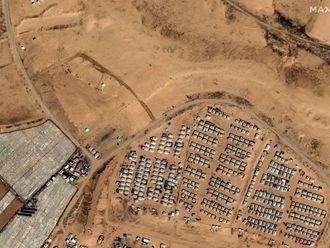Washington: The case of Mahdi Nemmouche haunts US intelligence officials.
Nemmouche is a Frenchman who authorities say spent 11 months fighting with The Islamic State of Iraq and the Levant (Isil) in Syria before returning to Europe to act out his rage. On May 24, prosecutors say, he methodically shot four people at the Jewish Museum in central Brussels. Three died instantly, one afterward. Nemmouche was arrested later, apparently by chance.
For US and European counterterrorism officials, that 90-second spasm of violence is the kind of attack they fear from thousands of Europeans and up to 100 Americans who have gone to fight for extremist armies in Syria and now Iraq.
The Obama administration has offered a wide range of assessments of the threat to US national security posed by the extremists who say they’ve established a caliphate, or Islamic state, in an area straddling eastern Syrian and northern and western Iraq, and whose actions include last month’s beheading of American journalist James Foley. Some officials say the group is more dangerous than Al Qaida. Yet intelligence assessments say it currently couldn’t pull off a complex, 9/11-style attack on the US or Europe.
However, there is broad agreement across intelligence and law enforcement agencies of the immediate threat from radicalised Europeans and Americans who could come home to conduct lone-wolf operations. Such plots are difficult to detect because they don’t require large conspiracies of people whose emails or phone calls can be intercepted.
The 2013 Boston Marathon bombings were like that, carried out by radicalised American brothers Dzhokhar and Tamerlan Tsarnaev acting on their own. So was the 2010 attempt to bomb New York’s Times Square by Faisal Shahzad, who received training and direction in Pakistan but operated alone in the United States.
Late last month, Britain raised its terror threat from “substantial” to “severe,” its second highest level, citing a foreign fighter danger that made a terrorist attack “highly likely.” The US didn’t elevate its national terrorist threat level, though White House press secretary Josh Earnest said the administration was closely monitoring the situation. Homeland Security Secretary Jeh Johnson said Friday that US authorities aren’t aware of any “specific, credible” threats to the US homeland from the group.
So far, Nemmouche is the only foreign fighter affiliated with Isil who authorities say returned from the battlefield to carry out violence, and some scholars argue the danger is overstated. But nearly every senior national security official in the US government — including the attorney general, FBI director, homeland security secretary and leaders of key intelligence and military agencies — has called foreign fighters in Syria and Iraq their top terrorism worry.
“While we have worked hard over the last year and a half to detect Westerners who have gone to Syria, no one knows for sure whether there are those who have gone there undetected,” said John Cohen, a Rutgers University professor who stepped down in July as the Homeland Security Department’s counterterrorism coordinator.
“And that’s why those of us who look at this every day are so concerned that somebody is going to slip through the cracks,” Rep. Mike Rogers, R-Mich., the House Intelligence Committee chairman, said Thursday on CNN. “They’re either going to get into Europe or they’re going to get into the United States.”
Unlike Al Qaida militants in Pakistan and Yemen, American and European passport holders who have secretly gone to fight in Syria can travel freely if they have not been identified as terrorists. US authorities are sifting through travel records and trying to identify the foreign fighters, but they won’t see all of them.
An American from San Diego, Douglas McAuthur McCain, was killed this week in Syria, where, officials say, he was fighting with Isil. The US is investigating whether a second American also was killed.
McCain is one of several Westerners over the last two years who proved themselves willing to kill or die for extremist groups or help them win new recruits.
Of the thousands of foreign fighters who’ve flocked to Syria, many have fought with the Al Nusra front, an Al Qaida affiliate and rival to Isil.
The group poses its own threat, American officials say, but poses less of a threat than does Isil, whose battlefield successes have made it a stronger draw for foreign fighters than any Jihadist group in recent history. It has seized advanced military equipment and has millions of dollars in cash.
Intelligence officials estimate that about a dozen Americans are fighting with Isil.
Nemmouche, who has a long criminal record, allegedly killed two Israeli tourists outside the Brussels museum entrance with a .357 Magnum revolver. Then he walked inside, removed an assault rifle from a gym bag and shot two museum employees in the face and throat, prosecutors say.
He was caught six days later during a random customs inspection of a bus from Amsterdam. With him were the murder weapons, authorities say, and a sheet scrawled with the name of Isil. He had intended to film the attack with a wearable video camera, authorities say, though it wasn’t working that day.
Abu Salha, the 22-year-old Vero Beach suicide bomber, was recorded in a series of videos before his attack. In one of them, he addresses the US public in American-accented English.
“You think you are safe? You are not safe,” he said. “We are coming for you, mark my words.”












